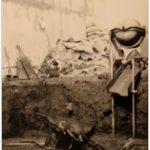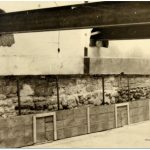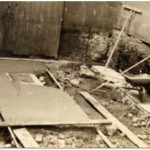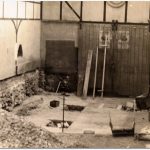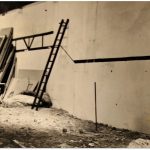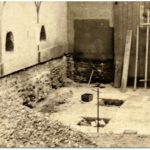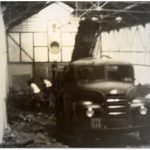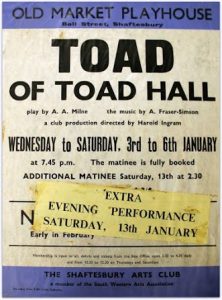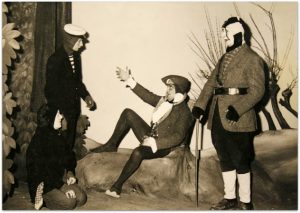History Of Shaftesbury Arts Centre

Was your appetite whetted by hearing the conversation between our own Anya Noakes and Rosemary King on The Alfred Daily on 1 June 2020 (go to around 13m 40s in)? Then search no more! Explore the history of the Arts Centre from this very page.
See the story featured on OutReach: Tales From the Village – Shaftesbury on August 20 2020
A Phoenix from the Ashes: The Story of The Old Marketplace Theatre and The Shaftesbury Arts Centre
Written by Anya Noakes
With thanks to Eric Olsen for allowing us to reproduce photos from his Images of England books ‘Shaftesbury’ and ‘Shaftesbury Recollections’ and to Mike Sims for his extensive historical knowledge and photos of the Arts Centre.
Arrival Of Moving Pictures And Creation Of The Arts Club
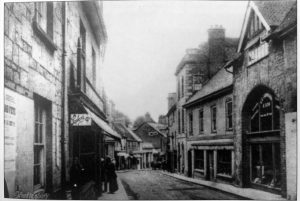
The Talking Pictures had arrived early in the 20th century and with them a cinema. Initially The Palace Picture House stood at the bottom of the High Street, with an ornate frontage of four large pillars, but it was demolished in 1925. The Savoy Cinema opened on Bimport in 1933 and seated 380 people. The owners of the house adjacent to the Savoy managed to prevent their metal railings being melted down for the war effort by claiming they stopped people queuing for the cinema from falling into their front garden.
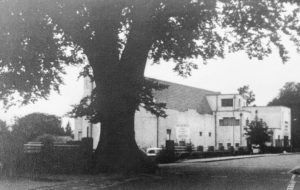
By austerity ridden post-war 1940’s Britain, entertainment was at a premium, largely enjoyed whilst huddled round ‘the wireless’ or limited offerings on a crackly black and white TV. Live entertainment was well nigh out of reach, often involving an expensive excursion to a nearby town on a precious day off. With this in mind, in 1947 the local committee of the Arts Council began to arrange the occasional concert and touring show in the Town Hall and elsewhere around town.
By 1949 it was clear that Thomas Hardy’s Shaston needed a permanent organisation of its own to encourage people to take part in the cultural life of the town. So it was that the Shaftesbury and District Arts Club was formed, with the grand sum of £5 0s 0d bequeathed by the old committee.
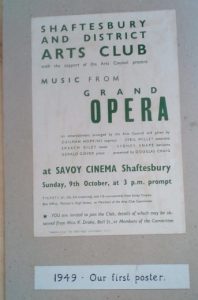 They were ambitious in their first offering: Music from Grand Opera began “at 3pm prompt” on Sunday 9th October in the (much lamented) Savoy Cinema. Performers included the wonderfully named Zuilmah Hopkins (soprano), Sybil Willey (contralto) and Sydney Snape (baritone). The audience were invited to join the Club by obtaining details from a Miss K Drake of Bell Street. Membership rose to 140.
They were ambitious in their first offering: Music from Grand Opera began “at 3pm prompt” on Sunday 9th October in the (much lamented) Savoy Cinema. Performers included the wonderfully named Zuilmah Hopkins (soprano), Sybil Willey (contralto) and Sydney Snape (baritone). The audience were invited to join the Club by obtaining details from a Miss K Drake of Bell Street. Membership rose to 140.
Later the same month the Drama and Music Groups were formed. In February 1950 the Drama Group presented its first three-act play “Knight’s Move” at the Grammar School Hall. Meanwhile, the Drama Group held its monthly meetings and rehearsals free of charge in the Grosvenor Hotel Ballroom “by kind permission of Col & Mrs Evans”, the latter being the first leader of the Drama Group. Later that year the Arts Club became affiliated to the British and Dorset Drama Leagues.
In June 1950, the club arranged its first Art Exhibition at The Town Hall including contributions from local schools. Two further Groups were formed in the next two years: the Camera Group in May 1950 and the Art Group early in 1951.
As the Arts Club became larger and their offerings more ambitious, they needed a home. Venues weren’t always available and whilst the Drama Group initially borrowed scenery, props and costumes, they began to make their own, which caused storage problems…
The Purchase And Conversion Of The Upper Market Hall
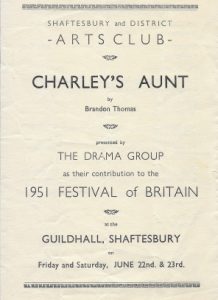 They were also busy getting “Charley’s Aunt” ready for Shaftesbury’s Festival of Britain programme in the summer of 1951 and had lost the loft they had been using as a storeroom. Local architect Eric Stevens raised the idea of purchasing the empty Upper Market Hall in Bell Street. In the meantime the Council gave them permission to use the building to prepare the three sets needed. The local Gardening Association were also looking for similar facilities so both Societies were able to help each other in the Festival venture.
They were also busy getting “Charley’s Aunt” ready for Shaftesbury’s Festival of Britain programme in the summer of 1951 and had lost the loft they had been using as a storeroom. Local architect Eric Stevens raised the idea of purchasing the empty Upper Market Hall in Bell Street. In the meantime the Council gave them permission to use the building to prepare the three sets needed. The local Gardening Association were also looking for similar facilities so both Societies were able to help each other in the Festival venture.
When this was over, the Council finally agreed to sell the Market Hall to the Shaftesbury and District Arts Club for the grand sum of £750. The Management Committee lost no time in drafting plans and presenting them to an Extra Ordinary Meeting on the 31st October 1951 attended by seventy members who approved them unanimously and promised between them to provide £460 towards the purchase price. Five Trustees were appointed, a separate bank account was opened and the purchase of the Old Market was completed in August 1952.
With money tight, a host of volunteers were drafted in to lend a hand with the building works. A considerable quantity of second-hand timber, flooring and doors was obtained from an old manor house. The burgeoning Club was helped by less formal financial assistance from many quarters. The Girls’ High School gave £25, half the proceeds from their school fete. There were donations too from performances given by Miss Belfield’s Chalke Valley School of Dancing and a joint Floral Display with the Gardening Association. The Club held its first open-air fete in Barton Hill, which brought in much needed publicity and £75. The Drama Group agreed to stage at least four productions a year in the Guildhall and elsewhere and other members went all out to raise funds with sales of artwork, bridge drives, concerts, picture exhibitions and raspberry teas.
During February 1953 a rota of club members offering help was formed. The volunteers began this ambitious project forming working parties in the evenings and at weekends alongside their day jobs and allowing for time to join in club group activities.
A local newspaper reported in August 1954 that members “had shifted over 200 tons of earth, broken up and removed over 100 tons of stone, mixed and laid 60 tons of concrete and salvaged over 2000 bricks”.
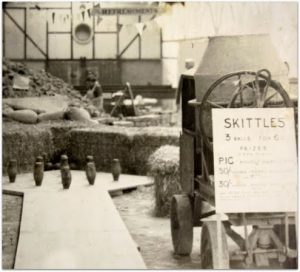
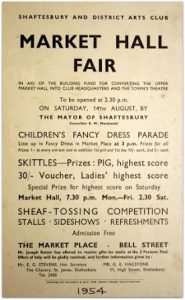 In the later more intricate stages of the work, the volunteers were helped by tradesmen and local builders who readily offered advice, as well as concrete mixers, wheelbarrows and essential tools: “Nor must we forget Mrs Gertrude Stevens and her apparently bottomless teapot, sustaining us at Committee and Group Meetings and rehearsals.” The conversion project took more than four and a half years to complete.
In the later more intricate stages of the work, the volunteers were helped by tradesmen and local builders who readily offered advice, as well as concrete mixers, wheelbarrows and essential tools: “Nor must we forget Mrs Gertrude Stevens and her apparently bottomless teapot, sustaining us at Committee and Group Meetings and rehearsals.” The conversion project took more than four and a half years to complete.
Meanwhile the Art, Camera, Drama and Music Groups met at other venues whilst monthly newsletters were issued. The Club published its first programme of group activities for the 1953-54 Season. The Drama Group presented a number of plays to help raise funds for their new home as well as taking excerpts to six Dorset Drama Festivals. Their 1954 entry – from the wonderfully named “Ladies in Retirement” – won through the first round at Dorchester, was placed first in the Southern Divisional Final at Bournemouth, and narrowly missed going through to the Western Area Final held in Malvern.
Grand Opening Of The Old Market Playhouse
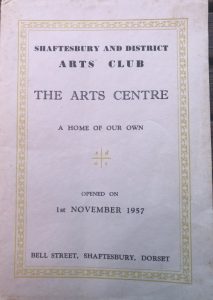 The Old Market Playhouse had its Grand Opening in November 1957 with a performance of “The Sleeping Monk” with proceeds going to the restoration fund of St Peter’s Church, Shaftesbury’s only surviving medieval building. A newsletter produced to coincide commented: “The Sleeping Monk” is known to some natives and more visitors as a rather weather-worn little figure who, from his perch in the north-west corner of St Peter’s north aisle, has watched the doings of Shastonians for some 800 years. He was not originally in the script but a chance enquiry by an Australian visitor has made him at once the title and the narrator of Miss Sydenham’s play.
The Old Market Playhouse had its Grand Opening in November 1957 with a performance of “The Sleeping Monk” with proceeds going to the restoration fund of St Peter’s Church, Shaftesbury’s only surviving medieval building. A newsletter produced to coincide commented: “The Sleeping Monk” is known to some natives and more visitors as a rather weather-worn little figure who, from his perch in the north-west corner of St Peter’s north aisle, has watched the doings of Shastonians for some 800 years. He was not originally in the script but a chance enquiry by an Australian visitor has made him at once the title and the narrator of Miss Sydenham’s play.
“We hope he will be well satisfied with what he sees and hears and that when he returns to his niche in St Peter’s on 12th November to resume his interrupted slumbers, he will sleep all the more soundly for discovering that Shaftesbury at least is awake.”
The eigh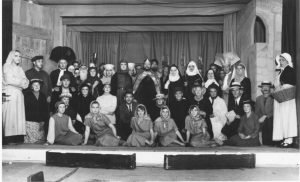 t performances sold out. As the eager audience entered from Bell Street, the Lobby and Foyer gave access to the exclusive Club Room. Stairs on the left hand side led to a small landing, the ladies cloakroom, a tiny office, and the Camera Group dark room. A narrow low-slung passage led to the theatre control room and housed the wardrobe. Only a very small person could stand upright, and to get into the control room you climbed over a roof truss. Next to the stairs was a door leading down to two small kitchens where the ladies brewed up tea and coffee, which was then passed up through a small hatch into the Club Room. The Theatre itself had a raked floor with 220 upholstered tip-up seats from the Stoll Theatre in London. The roof of the theatre had exposed steel roof trusses and tie bars. Down the left hand side were a series of glass skylights, which under heavy rain tended to leak onto the audience beneath!
t performances sold out. As the eager audience entered from Bell Street, the Lobby and Foyer gave access to the exclusive Club Room. Stairs on the left hand side led to a small landing, the ladies cloakroom, a tiny office, and the Camera Group dark room. A narrow low-slung passage led to the theatre control room and housed the wardrobe. Only a very small person could stand upright, and to get into the control room you climbed over a roof truss. Next to the stairs was a door leading down to two small kitchens where the ladies brewed up tea and coffee, which was then passed up through a small hatch into the Club Room. The Theatre itself had a raked floor with 220 upholstered tip-up seats from the Stoll Theatre in London. The roof of the theatre had exposed steel roof trusses and tie bars. Down the left hand side were a series of glass skylights, which under heavy rain tended to leak onto the audience beneath!
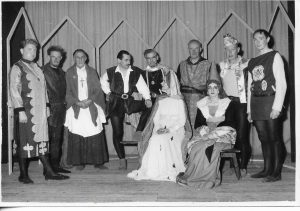 In 1958 the Shaftesbury Choral Society was born. Long-time Shaftesbury resident Mike Sims joined the Arts Club in 1962 and remembers taking part in the Juniors’ Day Entertainment “singing a duet with Valerie Croxford. Before I knew it I was taking part in my first play “The Queen and the Welshman” in a bit part as Page to the Queen! Not good for my street cred as I appeared in a tabard and tights and was ribbed mercilessly by my cricket and football buddies. My first big part was as Charles Wykeham in the eventful production of “Charley’s Aunt” the following year.”
In 1958 the Shaftesbury Choral Society was born. Long-time Shaftesbury resident Mike Sims joined the Arts Club in 1962 and remembers taking part in the Juniors’ Day Entertainment “singing a duet with Valerie Croxford. Before I knew it I was taking part in my first play “The Queen and the Welshman” in a bit part as Page to the Queen! Not good for my street cred as I appeared in a tabard and tights and was ribbed mercilessly by my cricket and football buddies. My first big part was as Charles Wykeham in the eventful production of “Charley’s Aunt” the following year.”
By 1962 the Management Committee realised it was time to consider altering and improving the facilities, especially at the stage end of the building. Plans were worked on: “By 1965 we had what we thought would improve our facilities with not too great an expenditure and these plans were sent in for approval.” But then disaster struck.
A Phoenix From The Ashes
In the early hours of Thursday 24th June 1965 a catastrophic fire broke out in the next-door premises occupied by a builders merchants and an electricians shop.
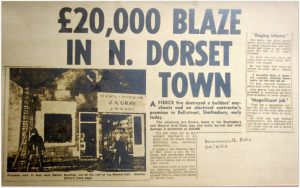
“Despite the best efforts of the Fire Brigade the fire spread, causing extensive damage. Luckily the front and stage areas were saved apart from smoke and water damage but the theatre roof had gone as well as the entire wardrobe and the control room. We lost all our theatre seats in the fire.Incidentally if you go past the ladies toilets in our current building and turn right through the door you will see a fire damaged beam over the emergency exit doors as a reminder of the fire.”
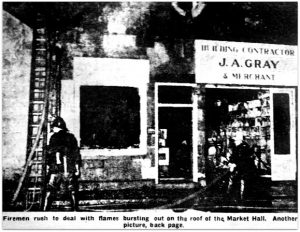 The day after the disaster the Management Committee managed to recall the plans from the planning authority for re-consideration. The shows continued in the Guildhall whilst a vacant property in Bimport served as storage for items salvaged from the premises and also hosted meetings and rehearsals. “Fortunately we were well insured and requested a cash payment towards the re-construction. Members sorted through the debris, salvaging where possible and I remember we held a sausage and mash evening amongst all the debris one evening!”
The day after the disaster the Management Committee managed to recall the plans from the planning authority for re-consideration. The shows continued in the Guildhall whilst a vacant property in Bimport served as storage for items salvaged from the premises and also hosted meetings and rehearsals. “Fortunately we were well insured and requested a cash payment towards the re-construction. Members sorted through the debris, salvaging where possible and I remember we held a sausage and mash evening amongst all the debris one evening!”
The Club Room had a ceiling added with “The Phoenix Room” above “rising out of the ashes”, with an area for serving refreshments. A new passage led to the control room with a new lighting console from the London Academy of Music and Dramatic Art. A greatly enlarged wardrobe was housed behind fire-proofed doors as well as a sizable workshop where sets are built and painted.
The opening ceremony took place on the afternoon of 3rd June 1967 with an evening concert presented by the Wessex Sinfonia. Meanwhile ‘Phoenix Bonds’ were introduced to help the Centre finances.
The Drama Group presented its first Christmas production, “Toad of Toad Hall” by A.A. Milne, produced and directed by Harold Ingram, formerly musical director of the Stratford-on-Avon Theatre, with beautiful sets by his daughter Pamela Ingram, Scenic Designer at the Yvonne Arnaud Theatre in Guildford. She also ran scenery workshops creating stage trees and river banks: “At an extremely late rehearsal on New Year’s Eve, Harold Keeping, who was playing Badger, fell backwards putting an end to rehearsals and possibly our New Year festivities. Fortunately Badger was wearing a thick jacket and belt so suffered no more than stiffness and bruising! The show was so successful we had to put on an extra performance on the second Saturday.” More than fifty Christmas shows and pantomimes have taken place since.
Since its opening the Centre was run on a club basis with Concert and Playgoers’ membership at 5p per annum. This type of membership grew to a little under 3,000, which meant quite a sizeable card index system! In 1978 it was decided to do away with this membership and apply for a public performance licence. By 1981 all necessary health and safety work was completed and a full Theatre Licence was issued. Another big step forward.
Meanwhile, totally out of character with its surroundings, the Savoy Cinema was eventually demolished in the 1980s making way for some flats and meaning that the Arts Centre now housed the only big screen in Shaftesbury.
Into The 21st Century
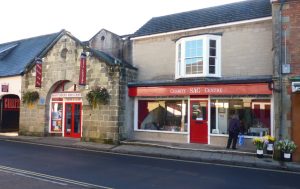
Over the ensuing years there have been major front of house improvements. Land at the rear was acquired in 1995. 2001 saw the Phoenix Room extension. Asbestos was removed in 2004 and more improvements were made. In December 2005 the Centre won the “People and Places” award for Best Individual Contribution to the Arts by an Organisation in North Dorset. In February 2007 the adjacent building was bought and housed a charity shop raising some £52k.
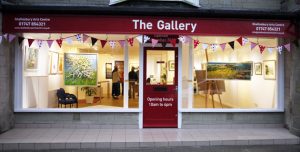 The lift, box office, Rutter and Proctor rooms were constructed. By 2011 there was an Oscar-computerised ticket and membership system installed, meaning box office staff no longer had to hand write every ticket. In 2013 the shop was converted into an art gallery, which meant the old gallery could be converted into a large open foyer with a bar.
The lift, box office, Rutter and Proctor rooms were constructed. By 2011 there was an Oscar-computerised ticket and membership system installed, meaning box office staff no longer had to hand write every ticket. In 2013 the shop was converted into an art gallery, which meant the old gallery could be converted into a large open foyer with a bar.
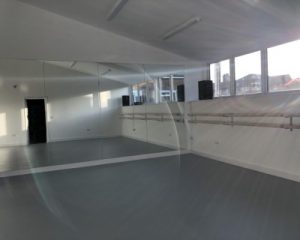
In 2018 the roof to the Proctor Room was raised, and in July the following year work began on the Dance Studio, completed in October 2019.
The Arts Centre is a hub of activity, with Music and Drama groups, the Bell Street School of Dance, a Poetry Group, art classes, a burgeoning Film Society screening recent releases as well as classic movies, sing-alongs, the Live Streaming of Ballets and the National Theatre Live (due to start in July 2020), along with all sorts of other activities: classical ballet classes, jazzercise, dancercise, the Shaftesbury Ukelele Band, the Shaftesbury Steel Band, an a capella choir, pilates, Zen and Dru Yoga, toddler workshops, digital champion sessions to help people master their computers as well as beauty offerings and sessions with Shaftesbury Chiropractic.
Meanwhile, in 2012, following the Queen’s Diamond Jubilee, the Shaftesbury Snowdrop Festival began with the planting of 60,000 bulbs. By 2014 the town began a heritage collection of rare and unusual snowdrops which draws in visitors from across the globe and which had a starring role in BBC One’s “Countryfile” just weeks before the whole country went into lockdown because of the corona virus.
The centre also houses events for the phenomenally successfully Shaftesbury Fringe Festival and will do for the inaugural Shaftesbury Literary Festival, due to be held this November. Shaftesbury Arts Centre looks forward to opening its doors again, welcoming everyone with its weekly Chat & Chill café and bar serving local produce, refreshments from Shaftesbury Wines and delicious local Purbeck ice-creams. Meanwhile the Art Gallery is always fully booked up well in advance, showcasing the talents of so many artists, drawing inspiration from an area that has always held a fascinating allure.
Click here for a brief history of our timeline.
If you have any further information about our history or any photos you’d like to share with us, please don’t hesitate to get in touch by contacting editor@shaftesburyartscentre.org.uk.

